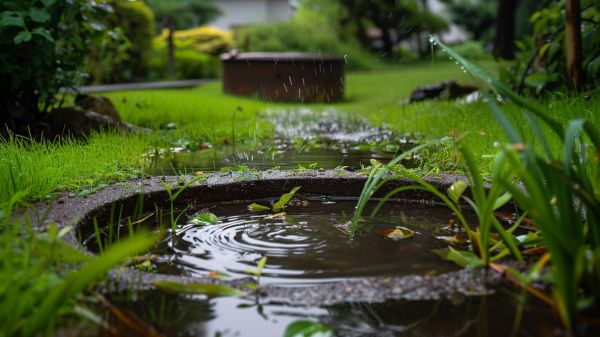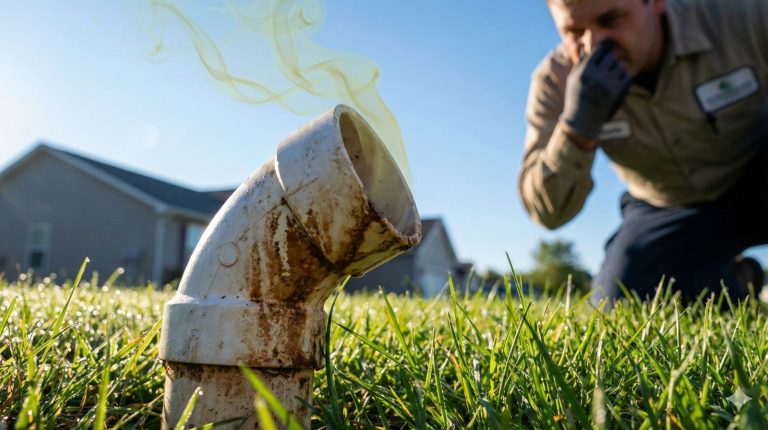Foul odors, like sewage or rotten eggs, signal septic tank problems, potentially posing health risks from gas buildup. In this article we’ll be discussing 5 common signs of septic tank problems for you.
Slow drains indicate system issues – address promptly to prevent system failure. Standing water near the tank needs immediate attention to prevent contamination and damage.
Lush green grass may reveal leaks or overflows, needing urgent inspection and maintenance. Wastewater backup is a clear sign of septic tank issues requiring immediate action to prevent health hazards and property damage.
Recognizing these signs early can save you from costly repairs and maintain your system’s efficiency.
Key Takeaways
- Foul odors like sewage or rotten eggs indicate septic tank issues.
- Slow drains signal potential septic system problems, requiring immediate attention.
- Standing water near the septic tank signifies a systemic issue that needs swift action.
- Green, lush grass may indicate septic tank leakages, necessitating inspection.
- Wastewater backup poses health risks and property damage, requiring immediate resolution.
Foul Odors
Guarantee odors emanating from your home serve as a critical indicator of potential septic tank issues, signaling the accumulation of gas and waste within the system.
These odors, often likened to the stench of sewage or rotten eggs, are a clear indication of gas buildup, particularly methane, which poses health risks due to the presence of harmful bacteria.
Immediate attention is paramount when such odors are detected to prevent further complications such as sewage backup and to maintain septic system efficiency.
Neglecting the foul odors associated with septic tank problems can result in serious consequences, both for the system’s functionality and for the health of individuals within the household.
Prolonged exposure to these odors can lead to symptoms like headaches and nausea, highlighting the importance of addressing any underlying septic tank issues promptly. By recognizing and acting upon these warning signs, homeowners can secure the proper functioning of their septic systems and safeguard against potential health hazards.
Slow Drains
Indicative of potential septic system issues, slow drains may signal a full septic tank due to solid waste accumulation impeding water flow capacity. When slow drains are ignored, the risk of septic system failure increases, potentially leading to health risks, property damage, and sewage backing up into the home.
The accumulation of solid waste within the septic tank not only affects drainage but also compromises the overall efficiency of the septic system. Addressing slow drains promptly is vital to prevent costly repairs and further damage to the property.
Ignoring the signs of slow drains can result in a domino effect of problems, including contamination of the surrounding soil and groundwater, foul odors, and even structural damage to the property. The cost of repairs escalates as drainage problems persist, making it essential to take immediate action at the first indication of slow drains.
Maintaining a proactive approach to septic system maintenance can help prevent these issues and guarantee a healthy home environment for all residents.
Standing Water
The presence of standing water in proximity to the septic tank indicates a potential systemic issue necessitating immediate attention to prevent environmental contamination and guarantee peak functionality. Standing water pooling around the septic tank can stem from various issues such as a full tank or drainage problems.
This excess water not only poses environmental contamination risks but can also lead to health hazards and property damage if left unaddressed.
Wet areas in the yard resulting from standing water signify an imbalance in the septic system, highlighting inefficiencies that require prompt maintenance.
To mitigate the risks associated with standing water near the septic tank, swift action is imperative to safeguard the functionality of the septic system. Neglecting this warning sign can result in long-term complications that extend beyond property damage, affecting the overall efficiency of the septic system.
By prioritizing maintenance and addressing drainage issues promptly, homeowners can guarantee the proper operation of their septic tanks and prevent potential health and environmental ramifications.
Green Grass
Excessive vibrancy and lushness of grass above the septic tank area can serve as a visible indicator of potential leakages or overflows within the system, suggesting a need for immediate inspection and maintenance.
When a septic tank leaks or overflows, it releases excess nutrients into the surrounding soil, acting as a natural fertilizer that promotes the growth of vibrant green grass above the affected area. This lush grass is a result of the wastewater reaching the surface and providing the necessary nutrients for the grass to thrive.
Green patches or stripes of grass above the septic tank should not be ignored, as they signal a leak or overflow issue that requires prompt attention to prevent further damage to the system.
Professional inspection and maintenance are essential in addressing septic tank problems to ensure the proper functioning of the system and prevent environmental contamination.
Wastewater Backup
A clear indication of septic tank problems, wastewater backup signals a full or malfunctioning system that poses significant health risks and property damage if left unaddressed. Sewage backups can lead to the unwanted entry of sewage into your home through toilets, drains, and sinks, creating an environment ripe for potential health hazards.
Immediate action is vital when wastewater backs up to prevent further property damage and health risks associated with exposure to sewage.
These backups often stem from issues such as clogged pipes, tank overflows, or drainfield malfunctions within the septic system. Addressing wastewater backups promptly is essential to avoid contamination, foul odors, and the escalation of septic system failures.
Neglecting to resolve these problems promptly can result in extensive property damage and health concerns. Therefore, it is imperative to address any signs of wastewater backup promptly to safeguard both your property and well-being.
Related Post: A Comprehensive Look at Top 5 Unfiltered Septifix Reviews.
Frequently Asked Questions
What Are Signs of Septic Tank Problems?
Signs of septic tank problems include foul odors, slow drains, wet spots, gurgling sounds, lush grass, sewage backup, puddles forming, sinkholes appearing, high water bills, and health risks. Recognizing these indicators is essential for prompt resolution.
What Are the Signs That a Septic Tank Needs to Be Pumped?
Foul odors, slow drainage, wet spots, lush grass, gurgling sounds, soggy soil, sewage backups, health hazards, high water bills are signs that a septic tank needs pumping. Timely professional inspection can prevent costly issues.
How to Tell if Leach Lines Are Bad?
To determine if leach lines are failing, observe sewage smell outside, wet spots in the yard, and slow drains inside. These signs may indicate issues with the drain field, groundwater contamination, necessitating professional inspection for repair to avoid costly repairs and environmental impact.
How Do You Know if Your Septic Tank Is Backing Up?
To determine septic tank backup, watch for foul odors, slow drains, gurgling sounds, wet areas, and sewage backup. These signs, along with lawn damage, high water bills, sluggish toilets, grease buildup, or tree root intrusion, indicate potential septic system issues.
Conclusion
In summary, recognizing the unmistakable signs of septic tank problems is essential for maintaining the functionality of the system and preventing costly repairs.
Foul odors, slow drains, standing water, green grass, and wastewater backup are all indicators that there may be issues with the septic tank.
By identifying these signs early on, homeowners can address the problems promptly and guarantee the proper functioning of their septic system.




